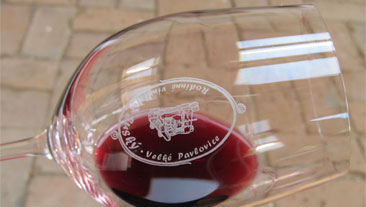winery Suský
Winery Suský Pavlovice
The winery Suský
Marek Suský comes from an old family wine. His grandfather was Mr. František Štambachr member of the Constituent National Assembly and a native of Great Pavlovic, important promoter of modern viticulture and enology and author of the bill for the study of garden engineering and the establishment of Faculty of Horticulture in Lednice.
Family Winery Suských belongs to a generation of winemakers holding the trend of production of small lots of quality wines with special attributes with a strong influence of his own hand and a clear manifestation of qualities Pavlovice wine region. Family winery processes grapes from the vineyards of excellent wine route Old mountains near the town of Great Pavlovice, which is the heart Pavlovice wine region famous for the production of quality red wines. The production of red wines is focused and our winery.
Part of the winery 2,5 ha of vineyards. A basis for the production of quality wines is professional work in the vineyard. In the production of wines in our winery combines modern technology with traditional knowledge. Grapes white varieties are processed cleanly and carefully controlled fermentation technology and subsequent batonáží and the red varieties also long maceration of the mash lasting several weeks. Wines further aged in oak barrels in stable climatic conditions originating cellar 16. century.
The tradition is also focused varietal grapes processed. After all varieties Grüner Veltliner, Pinot Blanc, Blue Portugal and Lemberger were documented as widespread in Moravia in the year 1883. Recently, we are trying to expand the production of varieties of André, Aurelius and Agni which first saw the light of day in the breeding station in Great Pavlovice wine and Cabernet Moravia typical for its distinctive flavor and with good ripening of the grapes and dramatically dark ruby color.
Marek Suský active member association velkopavlovických winemakers of presenting a series of wine, sports and tourism and cultural events for the general public, worth seeing.




factual information
annual production bottled fault : ca. 12 000 bottle
vineyard: 2,5 ha in the prestigious Old Mountain track in the land of wine Pavlovice
cultivated varieties whites:- Gruner Veltliner
- Pinot Blanc
- Cuvée white Suský (Pinot Blanc, Gruner Veltliner, Tram, Neuburské)
cultivated varieties red:
- blue Portugal
- Svatovavřinecké
- Zweigeltrebe
- André
- Frankovka
- Pinot Noir
- Cabernet Moravia
- Cuvée Susky červené (Frankovka, Svatovavřinecké, Zweigeltrebe)
possibility of tasting with commentary:
- cellar tour
- Wine tasting current offer
- maximum length of events 2 clock
- price 200,- CZK per person
excursions to vineyards with their own interpretation
Vineyard
Family winery processes grapes from 2,5 ha vineyard wine excellent track Old mountains near the town of Great Pavlovice, which is the heart Pavlovice wine region famous for the production of quality red wines. Mainly the production of red wines is focused and our winery.
Great Pavlovice are wine town with a long tradition. The beginnings of vine growing here date back to 14. century. Favorable climatic and soil conditions, long tradition and an ideal location city singled to, that became the center of the most productive wine region in the Czech Republic. Climatic conditions boundary to the south-facing slopes of the forest Ždánický, gently into the flatland. The city is protected from the north winds and open to the south winds and sunlight. Septuagenarian average annual temperatures of nearly 10 ° C, čtyřiačtyřicetiletý average hours of sunshine is 1,871 throw., while several years is higher than the number of hours 2.000.
Cut the vine is carried out on a towing size 8 – 10 stitches and Twin-one backup suppository. This ensures a good distribution of shoots on the bush, their smaller thickening and better climatic conditions. This is important to protect the vines, because it puts less demands on chemical plant protection. Towing is tethered to a guide wire horizontally. During the green works are the first two leaves on young wood removed and this allows better insolation and airiness grapes.
The first protective spray is directed into full bloom. This will spit partial restriction on the number of flowers and berries on individual grapes.
All our vineyards are grassed vegetation and chopped several times a year. Grassing is important not only for reasons of water retention in the soil, but also because of the hardening of the surface and allow access to vineyards for green jobs or plant protection.categories of wine
 ACCORDING TO THE SUGAR
ACCORDING TO THE SUGARdry: 0 – 4 g residual sugar per liter.
Polosuché: 4 – 12 g residual sugar per liter.
semisweet: 12 – 45 g residual sugar per liter.
sweet: minimum content 45 g residual sugar per liter.by color
White wine: It is made of white, pink or blue grapes. White wine from red grapes is called claret. The grapes are pressed immediately, without prior grinding of.
Pink wine: It is made from red grapes without fermentation. The grapes are pressed for several hours after the grinding, or soon after the grinding portion is separated from the shells must decantation or molding.
Red wine: It is made from red grapes nakvášením. Grapes after the grinding is fermented for several days to weeks, together with the skin and is usually pressed to complete the fermentation.ACCORDING TO CLASS AND TYPE
TABLE WINE
It is made from grapes, which reached the sugar content of at least 11 ° NM. Must not indicate the name of the variety.
Country wine:It is made from grapes, which reached the sugar content of at least 14 ° NM. It can indicate the name of the variety if the value is "Moravian wine" presented at double size.QUALITY WINE
Quality wine varietal:It is made from grapes, which reached the sugar content of at least 15 ° NM. Indicates the name of the variety.
Quality brand wine:The wine may be produced by mixing quality wine varietal. Name of wine manufacturer can choose according to their own discretion.Quality wine with attribute
Not to sweeten sugar.
Kabinett wines: produced from grapes, which reached the sugar content of at least 19 ° NM.Late harvest: produced from grapes, which reached the sugar content of at least 21 ° NM.
Selection of grapes: produced from grapes, which reached the sugar content of at least 24 ° NM.
Selection of berries: produced from selected grapes, which reached the sugar content of at least 27 ° NM.
Selection of raisins: It is made from selected overripe berries, which reached the sugar content of at least 32 ° NM.
Ice wine: produced from grapes, were harvested at - 7 And lower C, during harvesting and processing remain frozen and obtained must showed a sugar content of at least 27 ° NM.
straw wine: produced from grapes, which have been stored before processing on straw or hung on wires or networks in the ventilated space for at least 3 months, and obtained must showed a sugar content of at least 27 ° NM.
* The number of degrees NM (normalized normalizovaný muštomer) = The number of kg of sugar 100 kilograms must.
Vine variety from our vineyards
PINOT BLANC - Pinot blanc
Variety bud mutation arose as Pinot Noir, comes from Burgundy and only there can be referred to as "Burgundy". It has grown from time immemorial, but at least from the time of Charles IV. Originally named Roučí white. The wine is yellow-green color with inimitable bread-like flavors and aromas. It is an elegant wine with a long finish, the delicate scent of flowers, bread crust, hazelnuts and pears. Maturation takes a particularly high quality and fullness.
Veltlínské ZELENÉ - Grüner Veltliner
This variety probably comes from Austria, which is similar to our most widespread variety. It possesses also genes Traminer. It previously called the Bělošpičák, or Muškatel. The wine color is yellow-green to golden, spicy fresh taste with a pleasant acidity, spicy, fruity honey with velvety finish. Scent is linden honey and almond. Popular and pleasantly drinkable wine.
ANDRÉ
Bred in 1961 ing. Horak crossing Lemberger and St. Laurent in Great Pavlovice. It was named in honor of Ch. K. André (1763-1831), Brno who founded the first association for fruit cultivation in the world. The wine is intensely deep red garnet with purple tint, highly extractive, with full tannins and a harmonious flavor. Its character is approaching southern wines.
CABERNET MORAVIA
Bred in the Moravian Nova Ves p. Glos crossing varieties Zweigelt and Cabernet franc. The wine is similar to Cabernet Sauvignon with intense purple red, harmonic, pleasant spicy flavor and aroma of red berries.
FRANKOVKA – Lemberger, Blaufränkisch
This variety is grown from time immemorial and probably comes from Lower Austria or Croatia. Velkopavlovická in the region for this crop very favorable conditions. Smell and taste Lemberger presents several forms - young wine is harder, but wide, fully, maturation which acquires distinctive and delicious flavor and aroma, reminiscent of fresh grape, of stone fruit, wet straw, or meet with extractive finely kouřovinovými cherry and raspberry tones. The wine has a bright garnet red color.
MODRÝ PORTUGAL - Blue Portigieser, Portugieser Blau
Portuguese origin of this variety is not clear. For us to get in 18. century Austria. Previously most grown blue varieties. gives good, portly, delicious wines, intense ruby color with lower acidity. The bouquet includes May to gently spicy tone. The taste can detect forest fruit and fine, lighter tannins. Pleasantly drinkable wine, which calls for another sip.
PINOT NOIR - Pinot Noir
This variety is widespread throughout the world. Almost everywhere carries the original French name Pinot noir, Italy pinot nero, Spätburgunder in Germany and Austria Blauer Burgunder, Crni burgundac the Balkans, Kisburgundi in Hungary. He originally called blue Roučí. The French name for Pinot has a foundation in the word meaning cone Pin, because of its small grapes resemble cones of conifers. Gene analysis revealed, that has its origins in varieties Mlynářka (Pinot Meunier) a Tramín. Probably it is the random nature of crossing. To the Czech Republic gave it to import the Emperor Charles IV, where he first cultivated around Melnik. Scent of young wines reminiscent of blackberries, strawberries and black cherries. Later in the tones of the scent of decaying leaves, burning wood, dried plums and plum jam. On the palate the wine is very interesting, filled with very soft tannins and low acids. The color is generally pale ruby to brick red with golden edge. Such wines can be archived for many years.
SVATOVAVŘINECKÉ - Saint Laurent
Cradle of this variety is probably France, where from time immemorial, grown mainly in Alsace. According to the genetic analysis is related to burgundy varieties. Moravia penetrated in 40. years 20. century. For us it is the most widespread blue variety. It gives the wine a deep red color with dark garnet hue to Fialova, with a delicate fresh aroma and a full and velvety taste, reminiscent of cooked jam, black currants or dried fruit, accompanied by pleasant tannins.
Zweigeltrebe
The variety was bred in 30. years 20. century in Austria F. Zweigelt crossing varieties Lemberger and St. Laurent. It is more like Frankovka. V 60. He began to grow and Moravia. The wine has a delicate aroma, pleasant tannins, fruity bouquet and a medium-dark red. Maturing wine obtains intense balanced flavor fullness. Lately, its popularity is growing.

Pinot Blanc
Wine: mature,harmonic,full and rich in extractives. Color light yellow-green,almond scent

Neuburské
Wine: grown in a sheltered southern slope, high quality with good extract and lower kyselinami.Světle greenish-yellow color,smell neutral taste slightly bitter vanilla.

Gruner Veltliner
Wine: Typical harmonious with a delicate aroma of bananas, slightly bitter sauvignonový type.

Svatovavřinecké
Wine: dark red garnet color,fruity,Cherry flavor fragrance delicate tannin to plums.

Frankovka
Wine: typical full, spicy ruby, pleasantly rough. Aroma and flavor Cinnamon.
Where did the wine
Most scientific studies puts the origins of viticulture in the Caspian Sea. From there it spread to Asia Minor, Iran, Číny a Indie. Gradually, the cultivation of vines spread to North Africa, and later to Europe.
In Egypt, wine was produced according to preserved records of the tombs of the pharaohs already 3200 BC. Wine, but boha Osir, It was considered at that time the most important and noble beverage whose production and preservation has been paid great attention.
The earliest evidence of winemaking in the Czech Republic dates back to the reign of the Roman Emperor Proba (276-282), which lifted the ban on planting vineyards in Roman colonies beyond the Alps. From this period also remains the fulcrum of the Roman garrison of Vindobona (today Vienna) „Legio Decima Gemina, Pia Fidelis“. During excavations masonry buildings tenth legion military station near the former village Mušov near Mikulov found evidence of vine growing around the military camp. Findings wine knives and other tools are wine throughout southern Moravia numerous.
The beginnings of Bohemian viticulture apply according to legend, to the year 892, when Prince Bořivoj celebrated the birth of their son Spytihněv and on this occasion was gifted Moravian Prince Svatopluk barrel of excellent Moravian wine. Bořivojova wife Ludmila tasted wine and asked for a stone bowl, which he sacrificed some wine goddess of the harvest backpack:…. nepršal even before that no rain for three months, and thou done this, That night fell abundant rain upon the earth. I may know it and so everybody said,, that through the sacrifice of the wine country there was a watered…. Princess Ludmila then wanted to develop a winery for the first vineyard was founded in Nedomice at Melnik apprentice the secrets of wine production and her grandson Vaclav.
A greater expansion of vineyards occurs during the Great Moravian Empire. The first written mention of vineyards in Moravia, however, comes up from the year 1101 and is located in the charter of the Benedictine monastery in Trebic, who was presented with several vineyards.
Its undeniable influence on the development of medieval winemaking had a violent introduction of Christianity in non-Christian communities in our country in 11. – 13. century. Right planting vineyards, wine production and its šenkování, as well as exemption from certain obligations to the monarch was granted, or allow only Christians. The disposal not only the vineyards, but entire villages on grounds of illegal cultivation of vines there are a number of documents.
Known as the legislative steps the Czech kings 14. century, which was dealt a trade war between winemakers from Melnik and Litomerice during which they were repeatedly plundered not only the vineyards, but both cities. After one such attack, according remained extant reports on Melnik alive only 59 resident. Preservation of wine-viticultural knowledge, so it was no written records and manuals very difficult. Much more difficult, however, was the restoration of the fight, or plague destroyed winery.
Moravia was a dispute about the most important battle between Austrian and Moravian wine makers, which solved until the year 1325 King Jana Lucemburského regulation which determined preferential right tapping Moravian wines from the new harvest until Easter. The beginning of sales of young wines at the time of the feast of St.. Martina. With that, it is also related to the appointment of Regulation the first official wine taster.
In the second half 16. century come to Moravia Baptists Habáns. Their influence is reflected in the Winery. They worked in the planting of vineyards, when digging cellars, let to regularize as winemaker and also introduce new ways of growing vines, new varieties and yet unknown ways of treating the wine. As a result of these changes, there was a further improvement in the quality of wines and causing other trade war with Austria. Year 1569 Ferdinand I. meet at some time to Austrian winemakers and banned the import of Moravian wines in Austria. Moravian Diet blockade Moravian wines removed by, that in 1575 threatened to ban the import of Austrian wines, as well as its transport through Moravia to other countries. In this peak period of development was most intense wine regions around Moravia 170 000 ha of vineyards.
At the end 18. Century took the effort to restore Moravian wine after the decline of the Thirty Years War. In 1789 Moravia was counted only about 17 000 ha of vineyards. Total proceeds from the vineyards was estimated at 256 784 hl vína, which was about 15 hl for 1 he has, representing the optimum ratio for the manufacture of consumption. Gregory ranked by quality Free Moravian wines in 1784 thus: I. class - wines from Sedlec, Mikulov, Great Pavlovic, Popic and Lower Dunajovice.
Further decrease in vineyard area has caused the introduction révokaza (root aphid), It was in our country for the first time discovered in 1890 v Šatově. From America came to us not only phylloxera, which destroyed the original winery rooted vine, but oidium (fungal disease of plants) and at the turn of the century also peronospora, which are fungal diseases of the foliage and grapes, against which they help a regular and repeated several times during the vegetation spraying.
In 1901 for example, was founded the first state and municipal nurseries in Great Pavlovice the original area only 0,60 he has. It was a time when it was necessary to cultivate the vine and grafted seedlings which were to be replaced in the vineyards rooted vines are subject to upward pressure phylloxera. First grafts left school in year 1903. In 1904 It was built the first greenhouse stratification.
Year 1902 They were appointed first inspectors winery, whose main job was to fight phylloxera and fungal diseases. They were set up provincial and state nurseries with stratification greenhouses and planting of root stock. There they taught winemakers grafting vines resistant to phylloxera and the production of such rooted seedlings for planting new vineyards.
In 1901 for example, was founded the first state and municipal nurseries in Great Pavlovice the original area only 0,60 he has. It was a time when it was necessary to cultivate the vine and grafted seedlings which were to be replaced in the vineyards rooted vines are subject to upward pressure phylloxera. Here I have to state what it. Normally, he stuck into the ground rod vine and then it grew a plant. From America came to Europe that aphids sucking sap from the vine until the plant completely exterminated. Phylloxera destroyed the twenty years since the arrival in Europe 95 % All the vineyards in Europe! First grafts left school in year 1903.
In 1930 It was recorded the lowest area of the vineyard in Moravia. were counted 3 790 ha of vineyards.
In 1988 was the census of vineyards in Czechoslovakia recorded 45 000 ha of vineyards. Today, the Czech Republic planted just under 20 000 ha of vineyards and wine sold in stores is only about 30 % wines of domestic origin. Compared to the previous provisions of law 1995 establishes a classification of wines by achievement of quality grapes.
The winery is nice and hard work, and the market is only a few wines from Moravia and Bohemia, Therefore, it is necessary to weigh our domestic wines.
We recommend to eat
The white meat: Gruner Veltliner, Cuvée white Suský
The heavy meat dishes: Frankovka, André, blue Portugal, Cuvée Susky červené
venison: blue Portugal, Svatovavřinecké, Cuvée Susky červené
For festive occasions: Pinot Blanc, Frankovka, Cabernet Moravia, Pinot Noir
The Sldcostem: Cuvée white Suský, Svatovavřinecké - rosé
K sýrům: Pinot Blanc, Gruner Veltliner, blue Portugal, Svatovavřinecké
Helpful links
 www.vinozvelkychpavlovic.cz
www.vinozvelkychpavlovic.czPages velkopavlovických professional association of vintners' Wine of the Great Pavlovic ". Information about the wine-growers, wines and organized events in Great Pavlovice.
 www.velke-pavlovice.cz
www.velke-pavlovice.czŠrank city Pavlovice. Here you will find a lot of interesting and useful information about the city, Accommodations in, organized events, services offered, etc..
 www.velkopavlovicko.cz
www.velkopavlovicko.czguide Velkopavlovický wine sub-region. Useful information on organized events, accommodations, services offered, etc..
 www.forummoravium.cz
www.forummoravium.czMoravium Forum civic association organizes acclaimed eponymous wine competition and competition show Boardwalk red wines.
 www.vinnysklep.cz
www.vinnysklep.cza small encyclopedia of Czech and Moravian wines. Lots of information about the wine-growers, wines, wine events, etc.. Magazine about wine.
 www.vinarskyobzor.cz
www.vinarskyobzor.czspecialized magazine for wine, cellar management and wine shop.
 www.vinarskecentrum.cz
www.vinarskecentrum.czNational Wine Center including a permanent exhibition of the Wine Salon of the Czech Republic.
 www.woodcraft.cz
www.woodcraft.czcivic association on the website to learn not only sympathetic leisure activities.
Current photo gallery can be found at
- Marek Suský
Main 75
691 06 Pavlovice
tel. 723 286 832, 777 124 689
GPS coordinates cellar : 48°54’28.033″N, 16°48’54.426″E
photo gallery: http://vinosusky.rajce.idnes.cz
e-mail: mareksinsky@sthisnam.cz
eshop: http://vinosusky.cz/eshop/
web: http://www.vinosusky.cz






